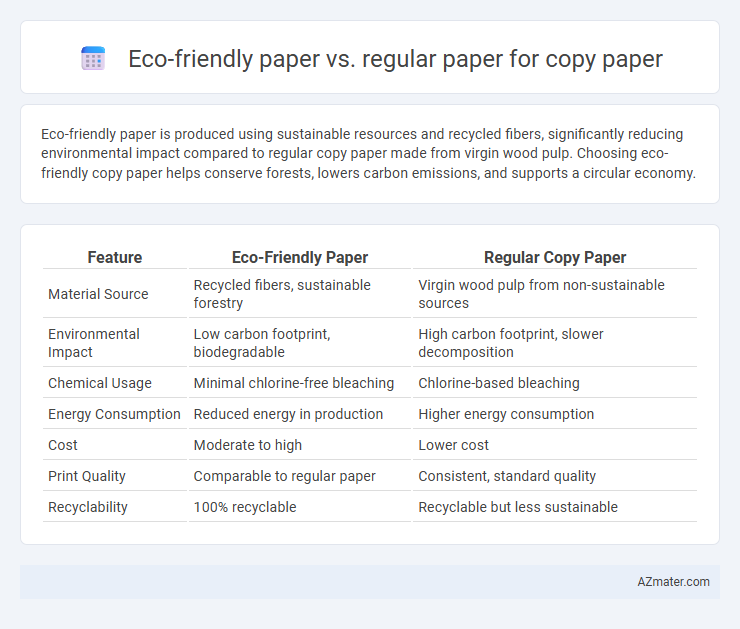Eco-friendly paper is produced using sustainable resources and recycled fibers, significantly reducing environmental impact compared to regular copy paper made from virgin wood pulp. Choosing eco-friendly copy paper helps conserve forests, lowers carbon emissions, and supports a circular economy.
Table of Comparison
| Feature | Eco-Friendly Paper | Regular Copy Paper |
|---|---|---|
| Material Source | Recycled fibers, sustainable forestry | Virgin wood pulp from non-sustainable sources |
| Environmental Impact | Low carbon footprint, biodegradable | High carbon footprint, slower decomposition |
| Chemical Usage | Minimal chlorine-free bleaching | Chlorine-based bleaching |
| Energy Consumption | Reduced energy in production | Higher energy consumption |
| Cost | Moderate to high | Lower cost |
| Print Quality | Comparable to regular paper | Consistent, standard quality |
| Recyclability | 100% recyclable | Recyclable but less sustainable |
Introduction to Copy Paper: Eco-Friendly vs Regular
Copy paper, a staple in offices and schools, comes in two main types: eco-friendly and regular. Eco-friendly copy paper is typically made from recycled materials or sustainably sourced fibers, reducing deforestation and environmental impact. Regular copy paper, often produced from virgin wood pulp, tends to have a higher carbon footprint and contributes more to waste.
Environmental Impact of Paper Production
Eco-friendly paper production significantly reduces environmental impact by utilizing recycled fibers, non-toxic inks, and sustainable forestry practices, leading to lower carbon emissions and decreased deforestation. Regular paper manufacturing often involves heavy energy consumption, chemical processing, and contributes to habitat loss and water pollution. Choosing eco-friendly copy paper supports resource conservation and minimizes ecological footprint in office environments.
Raw Materials: Sustainable Sourcing vs Conventional Logging
Eco-friendly copy paper is produced using sustainably sourced raw materials such as recycled fibers, agricultural residues, or wood from certified forests adhering to environmental standards like FSC or PEFC. Regular copy paper typically relies on conventional logging practices, often contributing to deforestation and habitat loss by using virgin wood pulp from non-certified sources. Choosing eco-friendly paper reduces environmental impact by promoting responsible forestry and minimizing resource depletion.
Energy and Water Consumption Differences
Eco-friendly copy paper significantly reduces both energy and water consumption compared to regular paper, utilizing up to 30% less electricity during production due to recycled fiber processes. Water usage drops dramatically by approximately 40% in eco-friendly paper manufacturing, as it often bypasses energy-intensive pulping and bleaching methods required for regular paper. These reductions contribute to a lower environmental footprint while maintaining comparable print quality for office use.
Chemical Usage in Manufacturing Processes
Eco-friendly copy paper is produced using significantly fewer harmful chemicals, minimizing the release of toxins such as chlorine and dioxins during bleaching and processing. In contrast, regular paper manufacturing often involves chlorine-based bleaching agents, contributing to environmental pollution and water contamination. Choosing eco-friendly paper reduces the chemical footprint and supports sustainable forestry and cleaner production practices.
Recyclability and Biodegradability
Eco-friendly copy paper offers superior recyclability due to its use of sustainable fibers and minimal chemical processing, reducing environmental impact compared to regular paper. It biodegrades faster because it lacks harmful additives and non-biodegradable coatings commonly found in conventional copy paper. Choosing eco-friendly paper enhances waste reduction and supports circular economy principles by facilitating easier recycling and natural decomposition.
Cost Comparison: Eco-Friendly vs Regular Copy Paper
Eco-friendly copy paper generally incurs a higher upfront cost than regular paper due to the sustainable materials and production processes used, which often include recycled content and reduced chemical treatments. However, long-term savings can be realized through reductions in waste disposal fees, energy consumption during manufacturing, and potential tax incentives for environmentally responsible purchasing. Businesses prioritizing sustainability may find that the marginal cost difference is offset by improved brand image and regulatory compliance benefits associated with eco-friendly paper products.
Print Quality and Performance
Eco-friendly paper for copy use often features recycled fibers and chlorine-free bleaching processes, resulting in slightly lower brightness but comparable print quality to regular paper. Print performance on eco-friendly paper generally maintains sharp text and color accuracy, though some high-resolution prints may show minor graininess. Regular paper typically delivers consistently smooth surfaces and vivid print results, making it ideal for detailed graphics and professional documents.
Certifications and Eco-Labels to Look For
Eco-friendly copy paper often bears certifications such as FSC (Forest Stewardship Council), SFI (Sustainable Forestry Initiative), and PEFC (Programme for the Endorsement of Forest Certification), ensuring sustainable forest management and responsible sourcing. Look for eco-labels like Green Seal and EU Ecolabel, which verify reduced environmental impact through stringent production and chemical use standards. Regular copy paper typically lacks these certifications, making eco-friendly options a better choice for reducing deforestation and promoting sustainable forestry practices.
Making the Switch: Tips for Choosing the Right Copy Paper
Selecting eco-friendly paper over regular copy paper reduces environmental impact by using recycled fibers and sustainable sourcing, which lowers deforestation and energy consumption. When making the switch, prioritize paper certified by organizations like FSC or processed chlorine-free to ensure eco-conscious production standards. Evaluate print quality compatibility and cost-effectiveness to maintain office efficiency while supporting sustainability goals.

Infographic: Eco-friendly paper vs Regular paper for Copy paper
 azmater.com
azmater.com